Cathedrals are not only significant sites for Christian worshippers, but they are also often stunning works of architecture that stand the test of time — making them a worthy addition to any travel bucket list. From a futuristic-looking midcentury marvel to a 110,000-square-foot Gothic stunner that took nearly six centuries to complete, these are six of the world’s most beautiful cathedrals.
Cathedral of Brasília – Brazil
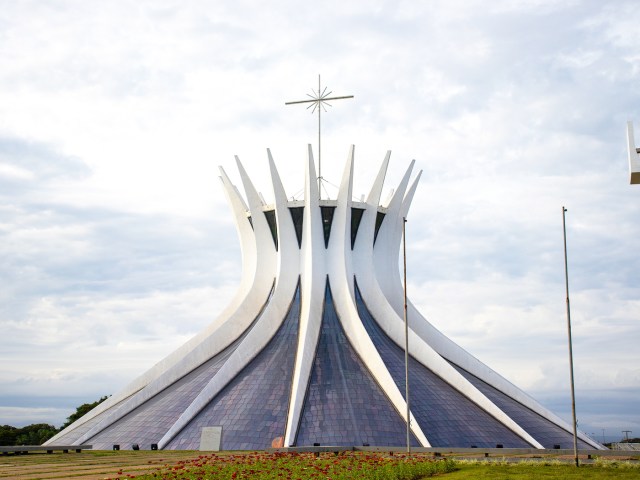
The spectacular Cathedral of Brasilia, designed in 1958 by legendary Brazilian architect Oscar Niemeyer, appears almost like a circular array of fingers pointed heavenward. This gorgeous midcentury structure is formed from 16 identical and massive boomerangs of white structural concrete leaning together in a circle. One of the most visited sites in the Brazilian capital, the Catholic church now attracts nearly 1 million visitors per year.
But the cathedral’s size and shape aren’t its only marvels. In the triangular spaces left between the concrete ribs, stained glass with a modern abstract design of white, blue, green, and tan provides a colorful ceiling from which three angel sculptures hang. And leading up to the entrance, there are four towering statues of Matthew, Mark, Luke, and John — the four Evangelists — cast in bronze. Finally, around the base of the exterior of the church, a serene pool gloriously reflects the image of the church back to the sky.
Seville Cathedral – Spain
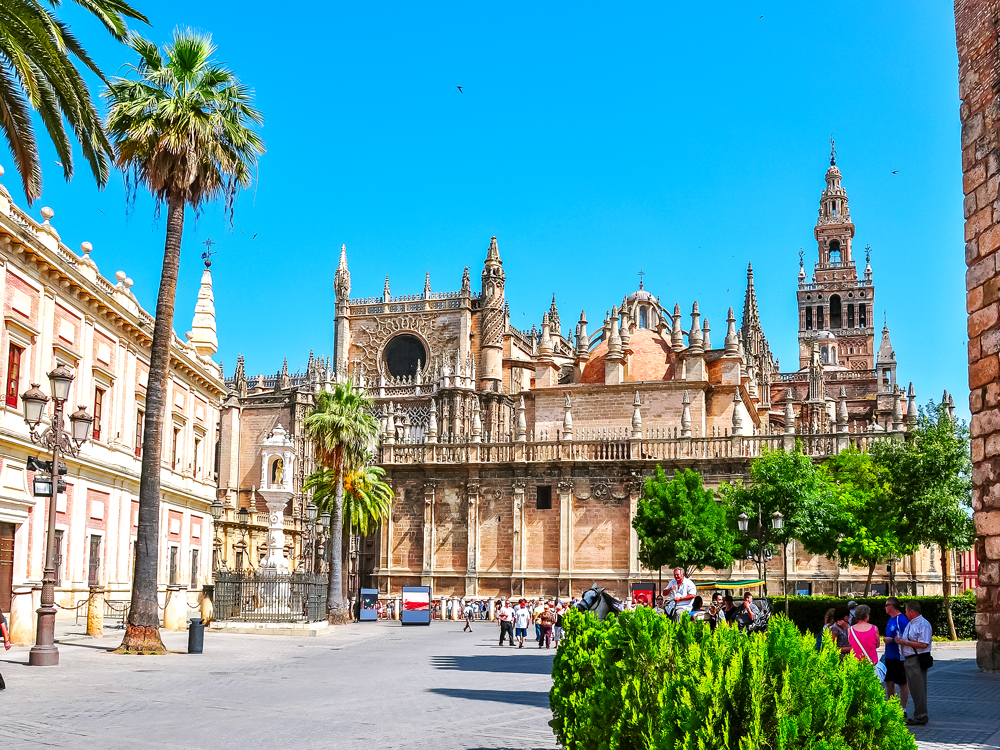
A dazzling display of the wealth that emerged in this southern Spanish city (now the capital of Andalusia) after the Reconquista years, Seville’s cathedral remains the largest Gothic building in Europe. Following the defeat of Moorish rule in the 15th century, Seville city leaders ordered the construction of the cathedral (officially named Cathedral of St. Mary of the See) to show off the expansion of Christianity throughout the Iberian Peninsula.
The cathedral stands on the site of a former mosque, and upon its completion in 1506, it overtook Istanbul’s Hagia Sophia as the world’s largest cathedral. (While it no longer holds that title, it’s still the third-largest cathedral in Europe.) One of the cathedral’s most distinctive architectural features is a nod to its former purpose — a 343-foot-tall minaret called the Giralda. Another famous feature lies deep within — the cathedral is also the final resting place of explorer Christopher Columbus. Together with Seville’s Alcázar royal palace and the city’s ancient merchant exchange, it was named a UNESCO World Heritage Site in 1987.
Cathedral of St. Paul – Minnesota
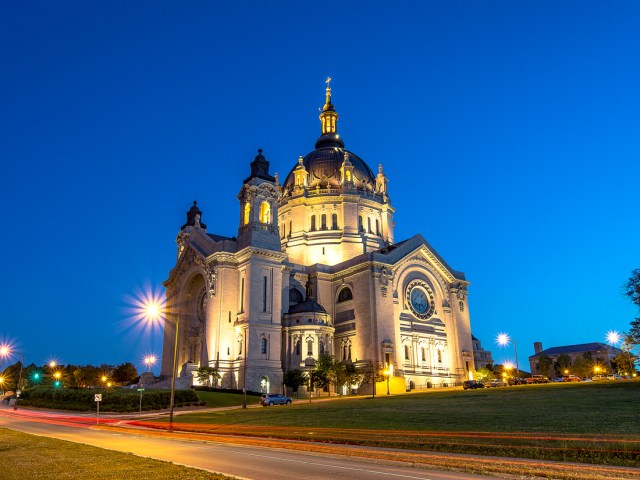
Built on Summit Hill, the highest point of St. Paul, between 1906 and 1915, the massive Cathedral of St. Paul looked to Europe for inspiration. A copper-clad dome and tall lantern rise 306 feet high between two 150-foot stone towers framing a classical Greek-cross layout. The grand Beaux-Arts architectural style may lend a European air to the cathedral, but there’s local pride there, too: The exterior is clad in Minnesota granite, and the interior in Minnesota travertine.
The soaring and open interior offers clear views of the altar from nearly every seat in the pews, without the obstruction of supporting pillars. In addition to sunlight from the interior dome, dappled light enters the transept through large and intricate rose windows on the north, south, and east walls. Among the chapels that line the walls of the cathedral, six are dedicated to the patron saints of six Catholic groups that settled in St. Paul: the Irish (represented by St. Patrick), the Italians (St. Anthony of Padua), the French Canadians (St. John the Baptist), the Germans (St. Boniface), the Slavs (Sts. Cyril and Methodius), and the early Jesuit missionaries of France (St. Therese of Lisieux).
St. Basil’s Cathedral – Moscow, Russia

Located in Moscow’s Red Square near the Kremlin, St. Basil’s Cathedral (officially, Pokrovsky Cathedral) was constructed in the mid-16th century by the first Tsar of Russia, Ivan Vasilyevich. You may know him as Ivan the Terrible — so-named for his legendary temper — and one of the most persistent myths around his rage involves the mystery of who actually designed the cathedral. Legend has it that Ivan blinded his architect so the majestic St. Basil’s could never be replicated. But was the architect an unknown Italian or a pair of Russians named Barma and Postnik Yakovlev? No one actually knows.
No matter who designed it, the cathedral is an undeniable masterpiece (though not one that can be easily visited given current geo-political tensions). Nine separate red brick chapels surround a 156-foot central nave. Each chapel is aligned to points on the compass and dedicated to a different sacred figure associated with the tsar. St. Basil’s is probably most famous for its bold exterior capped by brightly painted onion-shaped domes, but neither the colors nor the domes are original. The structure was white and gold until the 17th century, when the flared cupolas — a hallmark of Ottoman design — were added. They became a signature of Russian architecture and are now a common feature among monumental buildings across the country.
Il Duomo – Milan, Italy
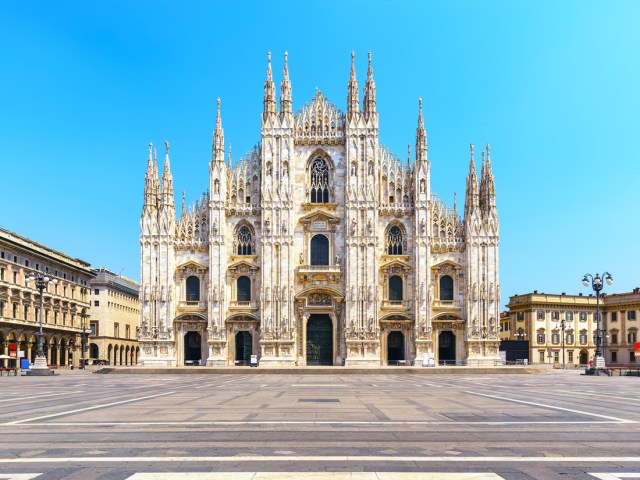
At almost 110,000 square feet and with room for 40,000 people, this gothic cathedral is Italy’s largest church. But Milan’s Il Duomo goes big on more than sheer size: The construction took nearly six centuries to complete, from 1386 to 1965, and to this day requires fresh supplies of Candoglia marble to touch up the stunning yet susceptible rosy-white facade. Then there are the big names involved in the project, from Leonardo da Vinci (one of many artists and architects who attempted a design for the difficult lantern tower) to Napoleon Bonaparte, whose coronation here spurred the completion of the facade.
A standout figure of a different kind? The tally of resident statues, said to outnumber any other church in the world. There are more than 3,400 in all, including an estimated 2,000 on the roof. Walking tours through the iconic spires tend to note the most prominent saints (the golden Madonnina), the least expected celebrities (20th-century heavyweight champ Primo Carnera), and everyone in between. For some visitors, however, the church’s biggest draw is actually quite small: a single nail believed to have come from Jesus’ cross.
Las Lajas Sanctuary – Colombia
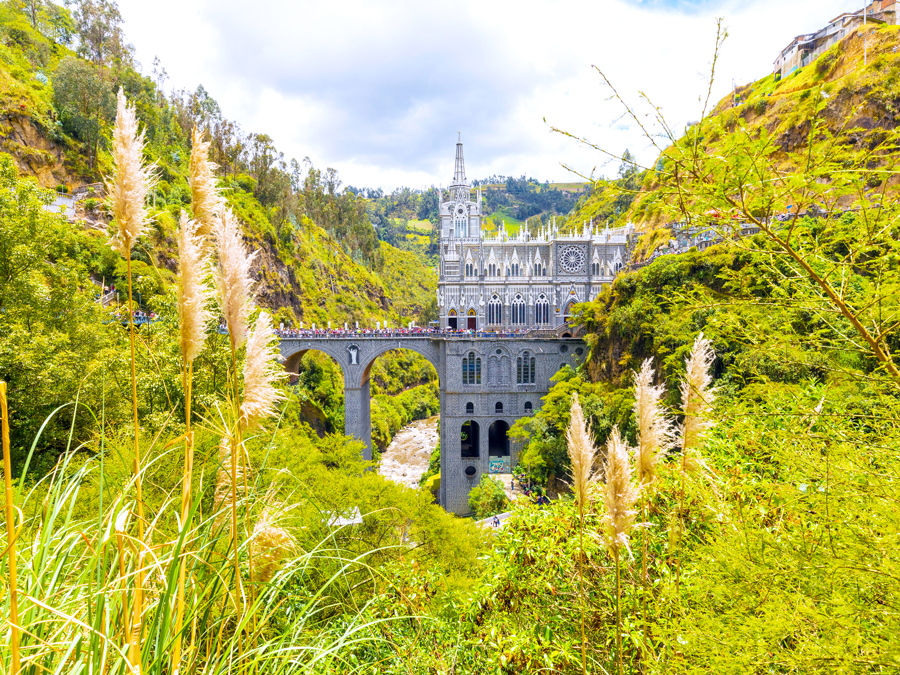
Though not technically a cathedral (rather, a Catholic minor basilica), this 150-foot-tall neo-Gothic church suspended over the canyon of the Guáitara River in southwest Colombia is worthy nonetheless of a pilgrimage. The sight of Las Lajas instantly recalls stories by the nation’s most famous author, magical realism pioneer Gabriel García Márquez.
In fact, the creation of a sanctuary site here was inspired by a similarly magical legend: During a 1754 storm, an Indigenous woman named María Mueses de Quiñones and her deaf-mute daughter, Rosa, found refuge in a cave in the Andes mountains, almost 10,000 feet above sea level. Inside, Mueses de Quiñones claimed they experienced a holy vision, discovering a likeness of Mary, the mother of Jesus, in the surrounding stone. At that moment, Rosa reportedly gained the ability to hear and speak.
Their location in Ipiales, about seven miles from Colombia’s border with Ecuador, has become a religious pilgrimage site visited by 750,000 people each year. Initial straw and adobe shrines have been replaced with the seemingly impossible cathedral, built in 1949. Its architectural support comes from three walls built into the canyonside and a double-arched bridge that extends 160 feet to the other side of the ravine. Inside, the sanctuary frames the preserved stone image of the Virgin Mary behind its altar. Although cars can park within a short walk of the bridge, visitors may opt for the scenic 20-minute teleférico (cable car) ride from the nearby Pan-American highway.
More from our network
Daily Passport is part of Optimism, which publishes content that uplifts, informs, and inspires.























